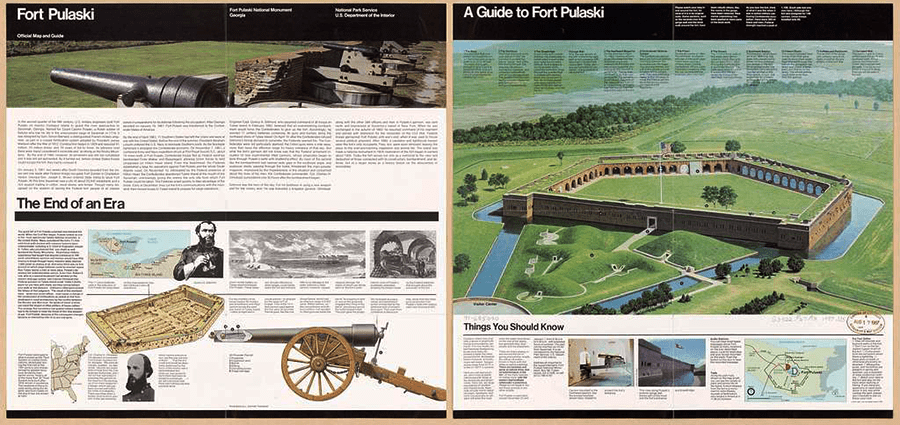Step back into Civil War history at Fort Pulaski National Monument near Savannah. This storied brick coastal fortress defended Savannah from Union forces for over a year until innovative rifle technology enabled its capture. Walk the fort’s moat, intact cannon-lined ramparts, and dark tunnels to experience 19th-century military life. Interpretive displays and films illustrate the pivotal 1862 battle that rendered brick fortifications obsolete. History comes alive through immersive activities, bringing visitors inside this turning point in warfare technology.
Location
The park sits 15 miles east of Savannah on Cockspur Island between the Savannah and Wilmington Rivers. From I-95, take exit 94 to US-80 E for a quick 12-mile drive to the site.

Details
Address: US-80 E, Savannah, GA 31410
Phone: (912) 219-4233
Website: https://www.nps.gov/fopu/index.htm
History
Construction began on Fort Pulaski in 1829 as part of America’s coastal defense system. It was strategically situated to protect the city of Savannah. Encircled by a wide moat, the fort utilized innovative construction techniques showcasing the cutting-edge military design of the time. However, by the time of completion in 1847, the fort was already becoming outdated against improved rifled cannon and shells.
On April 10, 1862, Union forces initiated the Battle of Fort Pulaski after surrounding the fort and positioning 36 guns on nearby Tybee Island. Within 30 hours, the rifled cannons breached Fort Pulaski’s 7.5-foot thick walls, forcing the Confederate to surrender. This battle demonstrated the superiority of rifles and rendered brick fortifications obsolete worldwide.
The National Park Service protects this pivotal Civil War site, where visitors can explore the remarkably preserved fort, view historical reenactments, and learn about battlefield technology.

What to See and Do
Start your visit at the visitor center museum to get oriented with history exhibits and an informative video detailing the 1862 battle. Interpretive displays explain innovative construction methods and how rifled cannons enabled Union victory.
Guided tours of the fort interior are available, taking you inside must-see areas like the cold, damp gunrooms and former prisoner barracks. Or take a self-guided tour to walk the perimeter along the ramparts and see 42 restored cannons lining the walls. The stone moat, drawbridge entrance, and tunnels provide an authentic military fortress experience.
Don’t miss ranger-led cannon firing demonstrations illustrating Civil War gunnery – a highlight for many visitors! Check schedules for living history reenactments bringing the fort’s history to life.
Finish at the bookstore for educational souvenirs. Kids love the Junior Ranger program activities.
Top Attractions
- Walking along the ramparts and moat
- Cannon firing demonstrations
- Battlefield reenactments
- Guided tours of the fort’s interior
- Informative exhibits at the visitor center
Nearby Attractions
Downtown Savannah is just 15 minutes west of here. This walkable historic district entices visitors with charming cobbled streets, antebellum mansions, unique shops, museums, and excellent dining.
Wormsloe State Historic Site and its picturesque 1.5-mile oak avenue near Savannah is a tranquil place for a sunset visit.
Tybee Island, just 10 minutes from Fort Pulaski, offers beaches, water recreation, seaside eateries, the Tybee Lighthouse, and ocean views.
The Savannah River, about 25 minutes from the fort, sits historic plantations like Bethesda Academy and New Ebenezer that can be toured.

Tips for Visiting
Fort Pulaski enjoys a mild climate year-round. Peak visit times are March-May and September-November when highs range from 65-80 °F.
Summers are hot and humid, with temperatures in the 90s°F. Take refuge in shady spots and indoor areas. Afternoon thunderstorms occur. Hydrate often.
Winters average mild 50-60 °F, but pack warm layers for shifting winds off the river. Some areas may close in bad weather.
Weekends draw the largest crowds. Arrive early to check schedules, take tours, and secure parking. Only cash is accepted for the entry fee.
Wear comfortable walking shoes for the expansive grounds. Bring water and snacks to refuel.
Leave drones and balloons at home – they are not permitted. Tripods require photography permits.
Accessibility options are available for navigating the fort’s high stairs and uneven terrain. Inquire at the visitor center.

Conclusion
Fort Pulaski National Monument takes visitors back to a pivotal Civil War battle, demonstrating how technological advances shaped modern warfare. Walking the moats and cannons evokes 19th-century military life inside this storied coastal fortress. An unforgettable history lesson awaits!
Respectful Conduct
As a preserved historic site, respectful behavior is required. Please refrain from touching, disturbing, or climbing on any of the historic structures or artifacts. Follow park rules, so future generations can learn from this well-preserved Civil War fort. Through understanding history, we strengthen our shared bonds.




